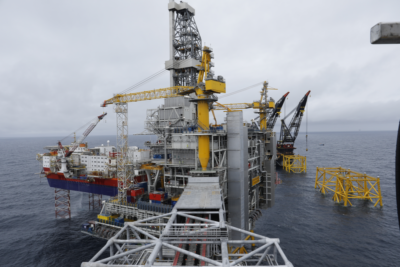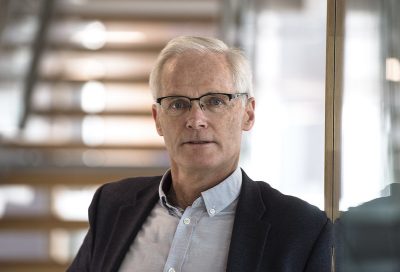NEW ANALYSIS: Windfall profits from Norway’s oil and gas industry aren’t only fueling the country’s fortunes. Ordinary Norwegians, like others all over the world, face extraordinarily high energy costs after Russia invaded Ukraine. Norwegian politicians, meanwhile, face a new “moral dilemma” as they also search for ways of boosting electricity production in a climate- and environmentally friendly manner.

Newspaper Dagens Næringsliv (DN) reported on Wednesday that Norway will probably earn more than six times as much on its oil and gas than the state government had budgeted. The finance ministry had expected an average USD 67 a barrel for Norway’s North Sea crude oil throughout the year, notes DN, but it hit USD 130 a barrel this week and gas prices stayed, too. That’s fueling prospects that Norway can generate as much as NOK 1,750 billion (USD 195 billion) from its offshore oil and gas fields this year, and some analysts think oil prices will exceed USD 200 a barrel this summer.
“It’s almost like you can’t believe it when you see the numbers,” Harald Magnus Andreassen, chief economist at Sparebank1 Markets, told DN. He views it as almost an embarrassment of riches that should prompt Norwegian politicians to share even more of it: “There’s clearly a need to evaluate whether we should be extra generous with foreign aid now.”
Electricity prices, meanwhile, are also generating huge profits for both public and private suppliers, and the Norwegian treasury. Taxes on electricity consumed in Norway are also supplying extraordinary gains for the state, to the point that politicians are “refunding” some of them through direct subsidies on bills for households, while no relief has been offered for most businesses or Norwegians’ beloved holiday homes called hytter. They’ve suddenly become much more expensive to maintain.
It all means that Norway as a country, though, stands to profit greatly on the misery of others. They range from those suffering under the war Russian President Vladimir Putin launched against Ukraine, to households and businesses at home, elsewhere in Europe and beyond that are suddenly faced with huge monthly bills for their electricity, heating and fuel.
Andreassen noted that Norway’s huge sovereign wealth fund, known as the Oil Fund, has warned that it may lose NOK 25 billion on its Russian investments. Norway stands to earn just as much on its oil and gas, he said, in the course of a week.
Meanwhile Petoro, the state company in charge of Norway’s direct ownership in oil and gas fields, reported its highest profits ever on Wednesday. It delivered a record NOK 186 billion to the state last year, up an astonishing 215 percent over 2020. That’s before oil and gas prices have skyrocketed since New Year, leaving Petoro’s chief executive Kristin Kragseth with some mixed feelings: “It’s fantastic to be able to contribute with such an amount to the Norwegian welfare state,” Kragseth stated, “but I also reflect over how this is not good for those who are dependent on buying our energy.”

Norwegians are reeling, too, from their recent monthly electricity bills that now amount to thousands instead of hundreds of kroner. Electricity used to be plentiful and one of the only things in notoriously expensive Norway that was cheaper than in many other countries. Now, however, electricity rates have been soaring because of a lack of rain and snow that has failed to fill reservoirs and generate the hydroelectric power that’s most Norwegians’ dominant energy source.
Yet another el-rate record was set in Southern Norway on Tuesday morning, when just one kilowatt hour of power including taxes hit NOK 10. That’s up from the less-than NOK 0.30 rates that were common just a year ago. Monthly electricity bills of less than NOK 300 for an apartment in Oslo last winter, for example, shot up to NOK 1,400 in January and will be higher now. “It’s become incredibly expensive,” Gert Ove Mollestad of Montel Energy News to state broadcaster NRK. “We’ve never see such high rates here before.”
Rates are even higher outside Norway, where lots of Norwegian electricity is sold via cable since markets were deregulated several years ago. Analysts are predicting ongoing increases in electricity rates and years of market instability ahead, especially after the US and EU moved to halt all oil trade with Russia. That’s bound to send electricity rates even high, especially in Germany and other European countries that had grown dependent on Russian oil and gas imports. Norway can’t produce enough to offset the loss.

The energy crisis has thus set off calls for re-regulation of the electricity market. Some politicians from the Center and Progress parties now seem to regret earlier deregulation and don’t want to send electricity via cable abroad any more. They’d rather keep it to boost supply and lower electricity rates in Norway. They’re also withdrawing support to electrify offshore oil platforms as a means of reducing carbon emissions, claiming Norway no longer has enough electricity to maintain a production surplus on the mainland.
Electricity rates and even higher prices for petrol at the pump (which surpassed NOK 25 per liter this week, equal to around USD 12 a gallon) have set off protest marches in addition to all the calls for re-regulation. Newspapers including Dagsavisen have editorialized in favour of having the same electricity rates all over the country (they’re currently much lower in Northern Norway, where there’s generally more snow, rain and wind).
The Socialist Left Party (SV) wants the state to take back control over the electricity market. One option, SV argues, is for the state to buy electricity and resell it to households and businesses via long-term agreements. SV also advocates renegotiating contracts with the EU and the UK to make sure that electricity exports can be regulated on the basis of demand and rates. Oil companies should be ordered to build their own offshore wind turbines to electrify their platforms, and the state could set a maximum price for basic consumption, with higher rates allowed for “luxury” or high consumption. Some politicians for the Labour Party, which leads Norway’s government coalition, also advocate rate control, especially in Bergen, Trondheim and Troms.
Many Norwegians believe the state has lost control over the electricity market, and become too bound by EU rules and regulations that Norway needs to follow through its trade agreement with the EU. Legal experts aren’t at all sure Norwegian politicians would be allowed to set a maximum rate, or regulate exports abroad.
The government, meanwhile, has responded to all the unrest over high energy prices (both fossil and hydroelectric) with the establishment of a new Energy Commission appointed just last month. It’s charged with assessing energy needs and proposing ways of increasing electricity production. The goal is for Norway to maintain surplus production of power and ensure that the country’s access to renewable energy (primarily hydroelectric and wind) will still provide industry with a competitive advantage. Relatively cheap electricity was long an advantage, but rising rates are also raising costs for aluminum production and other energy-dependent businesses.

The 15-member commission represents a wide range of interests from business, industry, local governments, labour and the environmental movement. The latter is especially on guard, because of a sudden interest in nuclear power plants (which have never been built in Norway) and harnessing more waterfalls and rivers for hydroelectric production.
“The commission will examine the fundamental dilemmas in Norwegian energy policy,” former Oil & Energy Minister Marte Mjøs Persen claimed just weeks before taking over as labour minister to replace Labour Party colleague Hadia Tajik. Norway’s new Oil & Energy Minister Terje Lien Aasland, has promised to carry on the work, especially after most Russian oil and gas won’t be an option for the European market. Norway is under more pressure than ever to produce more energy in various forms, both for itself and for export.
Electric shocks for months
Europe and Norway were already getting hit by electricity shocks even before Putin started attacking Ukraine because of weather, high carbon prices to reduce emissions and ongoing electrification. It seems few realized how much electricity would and will be needed for the so-called “green shift,” and perhaps the “ouch” factor of high bills will be the catalyst needed to boost conservation. As one Norwegian woman with three children and a house in a chilly coastal area told newspaper Dagens Næringsliv (DN) in January, “We have a decent household budget, but electricity bills of NOK 7,000 (nearly USD 800) every month plus nettleie (the extra cost to cover electricity network distribution) are not sustainable.”
The government has promised to extend its monthly electricity subsidies beyond March 31, but fundamental issues must be addressed. Re-regulation appears unlikely, with the chief executive of state electricity producer Statkraft claiming last month that “we can’t just dismantle the energy market because prices are high.” Climate and Environment Minister Espen Barth Eide thinks Norwegians just have to get used to wide variations in electricity prices.
“This is not a Norwegian phenomenon, it’s happening all over Europe,” Eide told Dagsavisen. “Supply and demand are out of balance.” Norwegians are learning the hard way, meanwhile, that they no longer can take their formerly low electricity bills for granted.
“One of Norway’s advantages has long been access to clean, abundant and reasonable electricity, and that should continue,” Eide said. “At the same time, competition over that electricity will be greater as so much more becomes electrified (to cut carbon emissions). It’s more important than ever that we use electricity wisely and don’t waste it.
“There’s no doubt,” Eide added, “that we have long been used to such reasonably priced electricity that we didn’t always remember that it’s not an unrestricted resource.” Especially after Russia’s war over Ukraine is likely to be the worst and most disruptive for Europe and the world since World War II.
newsinenglish.no/Nina Berglund

